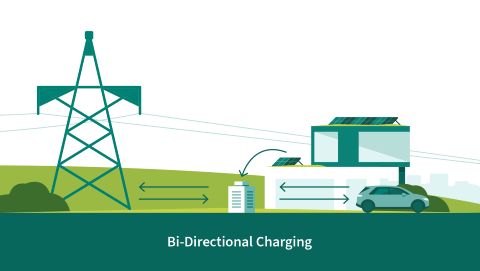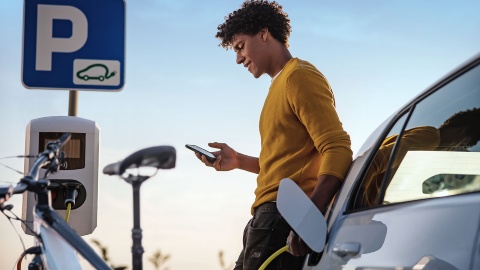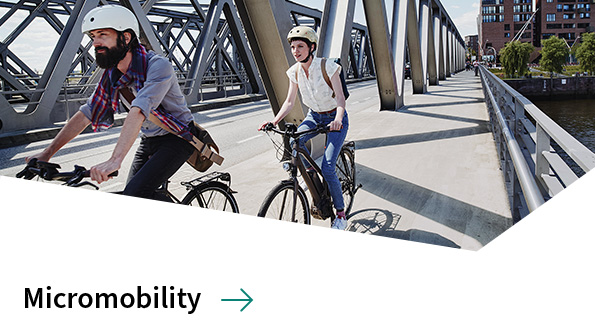
Charging infrastructure
Paving the way to a seamless charging infrastructure
Battery-powered electric vehicles are driving sustainable mobility - from e-bikes to heavy-duty trucks. However, in order to leverage the opportunities of electro-mobility which contributes to decarbonization, several conditions must be met: Not only does the electricity have to come from renewable sources and the vehicles themselves have to be affordable, it is also crucial that charging points are available in a comprehensive network and that charging times are kept as short as possible. As the market leader in power electronics Infineon is a key enabler here, helping to make ubiquitous and energy-efficient charging infrastructure a reality.
Expansion of the charging network
Drive the expansion of the vital charging infrastructure
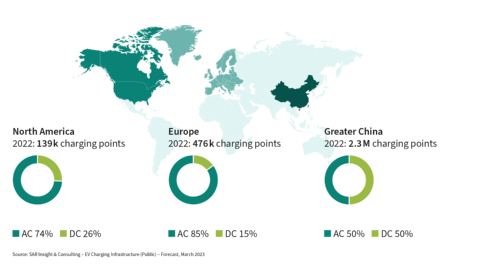
In the coming years, a broad network of energy-efficient and fast-charging infrastructures will be a main factor in achieving electrification targets in transport. Regional government initiatives aim at defining and installing public charging infrastructures with interoperable payment solutions to give users a seamless experience and clean mobility.
At the same time, charging points as well as the vehicles themselves have to operate and charge as energy-efficiently as possible. The type of charging station depends on where users charge and how much time they have – whether at home, at work or on the go.
Infineon products and solutions such as SiC-based devices are key to fast charging. Our range of complete one-stop-shop solutions and discrete services offered covers the entire product range from power conversion, microcontrollers, security and auxiliary power supplies and even communication.
On-board and off-board charging
Types of charging: Discover the difference
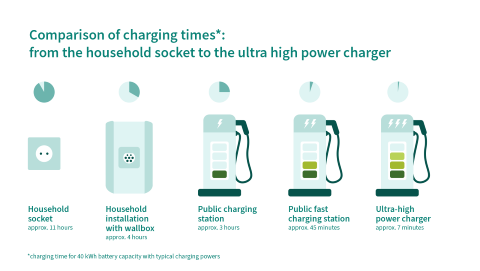
When charging an electric car, it is possible to use either direct current (DC) or alternating current (AC). But, since the drivetrain in an electric car needs direct current, alternating current has to be converted. Depending on where the conversion to DC occurs, there are two charging modes: on-board and off-board, both of which have their advantages in terms of speed (DC charging) versus lower costs (AC charging).
On-board chargers feed AC power from the outlet or charging station into the vehicle, where an on-board charger converts it to DC power in order to charge the battery. Conversely, off-board chargers internally convert AC power to DC power and then deliver it to the vehicle to charge the battery directly.
Infineon semiconductors enable both on-board and off-board charging designs. Whether discretes or modules, based on conventional silicon-based (Si) or cutting edge SiC topologies, our customers can choose from the wide portfolio of the leading power semiconductor supplier to drive the expansion of the EV charging infrastructure.
Conclusion: Looking beyond the car, semiconductors from Infineon are playing an important role in electric charging infrastructure. With their high-power ratings, they support ultra-fast charging. Infineon has developed battery management solutions for the efficient charging and monitoring of battery systems. In charging stations, the electricity from the grid is converted for storage in the battery. Here, particularly efficient semiconductors ensure that as much of the energy as possible reaches the car from the grid, making it available to the driver. In addition, new generations of semiconductors enable significantly faster charging than before.
Video: On board charger solutions: high flexibility and efficiency
Video: Get to know CoolSiC™ automotive discretes in 60 seconds
Application page: (H)EV on-board battery charger
Charging at home
For home charging, in most cases homeowners install a charging station (wall box) in the garage or somewhere outside the house. They just have to connect the charging cable and the electric car will charge overnight. The trend here is solar power: More and more homeowners are using the solar power from their roofs to recharge their electric cars. They use a photovoltaic system, a charging station and an energy management system. Adding an energy storage unit helps establish independence from charging in the daytime, when there is a lot of light.
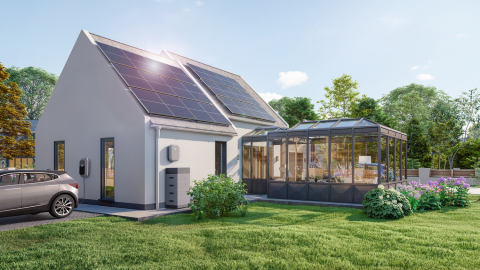
Charging at work
Another option is charging at work when the employer provides a charging infrastructure. Car users only need their own charging cable.
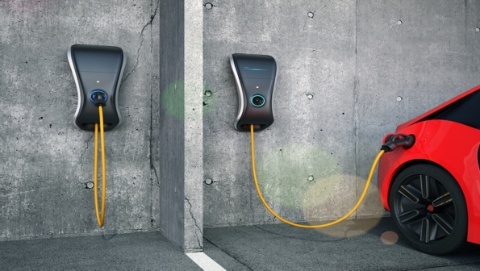
Public charging on the go
Particularly on long business trips or journeys, there is a need to use the public charging infrastructure, e.g. on highways. In this case, charging speed is crucial. Today, a typical electric car can already charge about 80% of its battery capacity in less than 10 minutes. This is not much longer than refueling a conventional car with an internal combustion engine.

Whether comfortable or athletic, e-bikes are becoming more and more popular among cyclists. To ensure that e-bike trips do not suddenly come to an end.
Bi-directional charging
A true game changer: Bi-directional charging
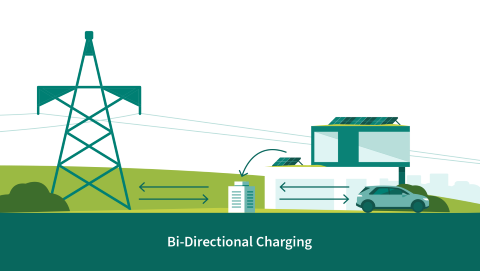
Two-way or bi-directional charging of electric vehicles provides a huge opportunity to turn electric vehicles into an additional energy storage system and save excess electricity, making it available when needed. This way, the battery of an electric car can be used as an energy supply for other devices. The technology enables batteries to be both charged and discharged, which is an important and innovative aspect of smart DC charging. For residential solutions using solar power, it will increase drivers’ independence and further help stabilize smart grids. The power can flow in two directions to cover different use cases, such as bridging power shortages, as a buffer for the private households and even reselling power to the grid with a Vehicle-to-Grid (V2G) option in the future. This means that this charging technology for e-cars makes it possible to feed unused energy from the battery back into the power grid. The vehicle’s battery then works like a very large power bank.
EV charging station: Chargers from 30 kW to 150 kW
While high-power DC chargers up to 350 kW offer fast-charging opportunities along the highway for quick top-ups, chargers providing up to 150 kW are the perfect solution for daily use in cities, filling the gap between residential and highway applications.
EV charging station: Chargers from 50 kW to 350 kW
High-power DC charging systems up to 350 kW let drivers add 200 km to their battery in about seven minutes – just enough time to have a cup of coffee. The technology that makes these chargers fast, efficient and accessible will help eliminate “range anxiety” among drivers.
Charging light vehicles
The battery module is a crucial sub-system in all light electric vehicles that drives the performance of the vehicle in terms of top torque and kilometer range. A highly efficient battery management system utilizes the lowest drain-source on-resistance of OptiMOSTM and Strong IRFETTM MOSFET for maximum short circuit current capability and lowest continuous operation conduction losses.
(H)EV on-board battery charger for hybrid / electric vehicles
The on-board charger (OBC) is the system built into the car which recharges the high voltage battery from the AC grid while the vehicle is parked. Longer driving ranges for plug-in hybrid (PHEV) and battery electric (BEV) vehicles are realized by increasing the battery capacity and the energy efficiency of the electric components.
DC Wallbox
DC wallbox technology will be the key element in charging infrastructure, enabling faster and smarter charging.
Read more about DC wallbox
How to charge an EV
Charging solutions
Infineon is a member of the CharIN initiative (Charging Interface Initiative e.V.). The goals of this global initiative are to develop, establish and promote a global charging infrastructure standard for all types of battery-powered electric vehicles.
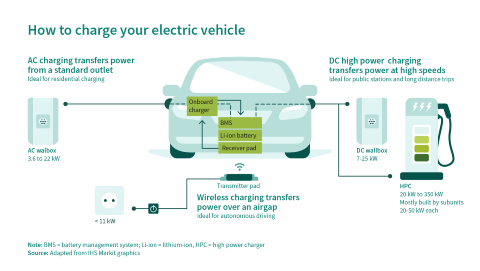
Semiconductors for each type of EV
Suitable semiconductors for all types of electric vehicles
Infineon’s semiconductor solutions are suitable for all types of electric vehicles: pure electric vehicles, plug-in hybrid vehicles and mild hybrid vehicles with 48-volt technology. Last but not least, Infineon components also cover vehicles based on emerging hydrogen technology.
Integrated Infineon components are the core building blocks of controllers and systems that are typical of electric cars: on-board charger, DC-DC converter, battery management unit, drivetrain controller, electric braking system as well as power steering, air conditioning, thermal management, rear light control, windshield wipers and window lifts. These components rely on the following product families: HybridPACK™ Drive IGBT power modules, AURIX™ microcontrollers, EiceDRIVER™ driver ICs and many other Infineon sensors, microcontrollers, power semiconductors and Wi-Fi®/Bluetooth® connectivity solutions.
Explore our portfolio for electromobility applications
Ultra-fast charging while shopping
Drivers who want to charge their electric cars while shopping can now do so in front of many supermarkets, DIY stores and furniture stores.
For the shop owners or shopping center operators, the installation of such fast-charging stations is associated with major construction measures, such as earthworks for laying the cables or pouring foundations.
The South Tyrolean manufacturer alpitronic has developed a solution for charging electric vehicles that requires considerably fewer construction measures. The new hypercharger HYC50 is the first wall-mountable system. It features an ultra-low noise level of less than 50 dBA. That way, the hypercharger can also be operated in or nearby residential areas.
The hypercharger has two fast-charging ports that can be used to charge either one vehicle at 50 kW or two vehicles simultaneously at 25 kW. The device is based on the SiC power modules MOSFET 1B and 2B in combination with the EiceDRIVER X3 from Infineon.
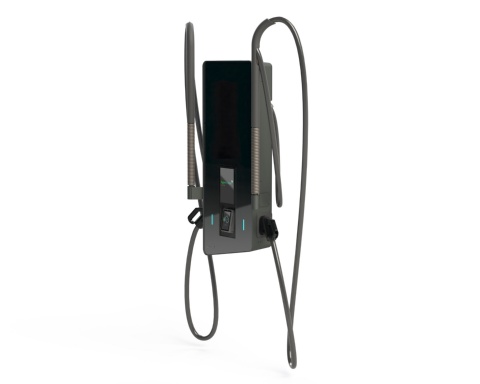
Facts and Figures
Bi-directional 50 kW (2 x 25 kW) DC-charging station for electric vehicles
The HYC50 is the first wall-mounted DC charger in this power range. By using Infineon’s CoolSiC™ technology, the power density has been increased by 50% and noise level has been reduced from 65 dB to less than 50 dB. The compact design, weighting less than 100 kg, enables deployment on walls of parking garages or supermarkets without major additional construction measures like reinforced foundations.
Integrated Infineon products
- EasyPACK 1B and 2B CoolSiC™ modules with NTC temperature sensor
- EiceDRIVER™ X3 driver ICs
HYC50 technical data
- 50 kW charging on one vehicle and 2 x 25 kW parallel charging possible
- Continuous 150 A charging current
- Output voltage 50 V – 1000 V
- Best in class efficiency > 97% (*)
- In- and outdoor installation
- Weight < 100 kg (*)
- Ultra low noise level < 50dBA (*)
- V2G ready (**)
(*) preliminary data to be verified
(**) V2G stands for “vehicle-to-grid". This technology makes it possible to feed energy from electric vehicle batteries back into the energy system.
Electric cars as buffer storage for solar power: Infineon and Delta enable bi-directional charging at home
Protecting both environment and wallet with bi-directional charging
Electric mobility has to be seen holistically to make sure it can contribute as much as possible to decarbonization: This involves the whole energy supply chain, from green power generation and transmission to efficient consumption and intelligent storage. Among other things electric storage systems are a key building block in compensating for the fluctuating availability of renewables to stabilize grids.
One innovative technology here that can make a big difference is bidirectional charging. It works like this: Homeowners, for example, can store solar power from their photovoltaic system in electric cars and home batteries first, before they feed it back into the home grid to power household appliances in the evening hours or when power is needed and the sun is not shining. Assuming that single-family homes consume an average of 10 to 15 kWh of energy per day, a fully charged car battery with a capacity of 30 to 100 kWh can theoretically bridge a few days as a backup power solution. Homeowners thus gain low-cost electricity as well as more power supply independence.
Three-in-one system for bi-directional charging
Infineon’s solutions for bidirectional charging make it possible for electric car users to charge solar power at home at low cost and use their vehicle as buffer storage system at the same time. To enable this, Infineon has developed a three-in-one system together with Delta Electronics, a Taiwan-based leading provider of power supply and energy management solutions. The system integrates a solar unit, home storage and charging station. Thanks to bi-directional inverters, the car now also becomes a buffer storage unit or the home’s backup power supply. Looking ahead, bi-directional energy flows will make it possible to realize further Vehicle-to-Home (V2H) and Vehicle-to-Grid (V2G) solutions.
Compound material SiC cuts losses by about half when converting electricity
With an output power of about 10 kW, Delta’s new system allows a maximum continuous current of 34 A and achieves peak efficiencies of more than 97.5 percent. Energy-efficient Infineon power semiconductor components made of silicon carbide (SiC) are used to increase power density. Compared to silicon-based semiconductors, the compound material SiC reduces energy losses by around half when converting electricity and cuts the size of charging stations by about 30 percent. SiC makes photovoltaic systems more efficient, shortens charging times at fast-charging stations and wall boxes and increases the range of electric cars by five to ten percent.
